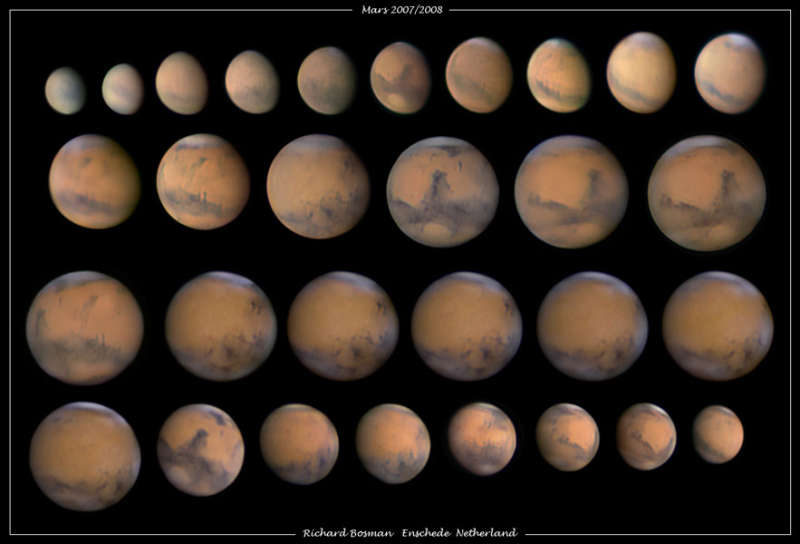
|
Credit & Copyright: Richard Bosman
Explanation:
Does Mars always appear the same?
No.
As both Earth and Mars orbit the Sun, the
apparent angular size
of Mars changes as viewed from the Earth.
Pictured above from
Enschede,
Holland,
Mars was captured in 2007 and 2008 with 30 separate images,
all taken with the same magnification.
When Earth and
Mars are on opposite sides of the Sun,
Mars appears relatively small.
Conversely, when Earth and Mars are near each other,
Mars looms large and bright.
The largest Mars has appeared in recent history was the
opposition of August 2003.
Since Mars is always more distant from the Earth from the Sun,
Mars never shows a crescent phase to Earthlings.
Visible also in the above images are the
north polar cap of Mars,
dark and light soil, clouds, and, in the early images, a global
dust storm.
The next opposition, when Earth again passes near to Mars, will occur in early 2010.
|
January February March April May June July August September October November December |
| ||||||||||||||||||||||||||||||||||||||||||||||||
NASA Web Site Statements, Warnings, and Disclaimers
NASA Official: Jay Norris. Specific rights apply.
A service of: LHEA at NASA / GSFC
& Michigan Tech. U.
Based on Astronomy Picture
Of the Day
Publications with keywords: Mars - angular size
Publications with words: Mars - angular size
See also:
- APOD: 2024 December 3 Á Ice Clouds over a Red Planet
- APOD: 2024 November 10 Á Valles Marineris: The Grand Canyon of Mars
- APOD: 2024 September 9 Á Mars: Moon, Craters, and Volcanos
- APOD: 2024 June 5 Á Shadow of a Martian Robot
- Ares 3 Landing Site: The Martian Revisited
- The Shadow of Ingenuity s Damaged Rotor Blade
- APOD: 2023 November 7 Á A Martian Dust Devil Spins By
